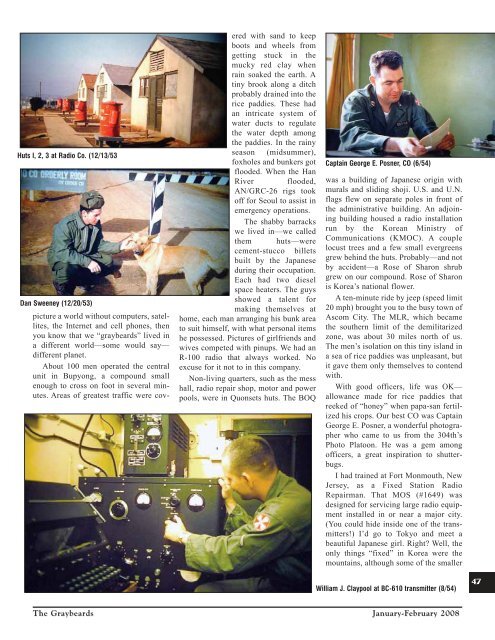Jan/Feb 2008 - KWVA - Korean War Veterans Association
Jan/Feb 2008 - KWVA - Korean War Veterans Association
Jan/Feb 2008 - KWVA - Korean War Veterans Association
Create successful ePaper yourself
Turn your PDF publications into a flip-book with our unique Google optimized e-Paper software.
Huts l, 2, 3 at Radio Co. (12/13/53<br />
Dan Sweeney (12/20/53)<br />
picture a world without computers, satellites,<br />
the Internet and cell phones, then<br />
you know that we “graybeards” lived in<br />
a different world—some would say—<br />
different planet.<br />
About 100 men operated the central<br />
unit in Bupyong, a compound small<br />
enough to cross on foot in several minutes.<br />
Areas of greatest traffic were covered<br />
with sand to keep<br />
boots and wheels from<br />
getting stuck in the<br />
mucky red clay when<br />
rain soaked the earth. A<br />
tiny brook along a ditch<br />
probably drained into the<br />
rice paddies. These had<br />
an intricate system of<br />
water ducts to regulate<br />
the water depth among<br />
the paddies. In the rainy<br />
season (midsummer),<br />
foxholes and bunkers got<br />
flooded. When the Han<br />
River flooded,<br />
AN/GRC-26 rigs took<br />
off for Seoul to assist in<br />
emergency operations.<br />
The shabby barracks<br />
we lived in—we called<br />
them huts—were<br />
cement-stucco billets<br />
built by the Japanese<br />
during their occupation.<br />
Each had two diesel<br />
space heaters. The guys<br />
showed a talent for<br />
making themselves at<br />
home, each man arranging his bunk area<br />
to suit himself, with what personal items<br />
he possessed. Pictures of girlfriends and<br />
wives competed with pinups. We had an<br />
R-100 radio that always worked. No<br />
excuse for it not to in this company.<br />
Non-living quarters, such as the mess<br />
hall, radio repair shop, motor and power<br />
pools, were in Quonsets huts. The BOQ<br />
Captain George E. Posner, CO (6/54)<br />
was a building of Japanese origin with<br />
murals and sliding shoji. U.S. and U.N.<br />
flags flew on separate poles in front of<br />
the administrative building. An adjoining<br />
building housed a radio installation<br />
run by the <strong>Korean</strong> Ministry of<br />
Communications (KMOC). A couple<br />
locust trees and a few small evergreens<br />
grew behind the huts. Probably—and not<br />
by accident—a Rose of Sharon shrub<br />
grew on our compound. Rose of Sharon<br />
is Korea’s national flower.<br />
A ten-minute ride by jeep (speed limit<br />
20 mph) brought you to the busy town of<br />
Ascom City. The MLR, which became<br />
the southern limit of the demilitarized<br />
zone, was about 30 miles north of us.<br />
The men’s isolation on this tiny island in<br />
a sea of rice paddies was unpleasant, but<br />
it gave them only themselves to contend<br />
with.<br />
With good officers, life was OK—<br />
allowance made for rice paddies that<br />
reeked of “honey” when papa-san fertilized<br />
his crops. Our best CO was Captain<br />
George E. Posner, a wonderful photographer<br />
who came to us from the 304th’s<br />
Photo Platoon. He was a gem among<br />
officers, a great inspiration to shutterbugs.<br />
I had trained at Fort Monmouth, New<br />
Jersey, as a Fixed Station Radio<br />
Repairman. That MOS (#1649) was<br />
designed for servicing large radio equipment<br />
installed in or near a major city.<br />
(You could hide inside one of the transmitters!)<br />
I’d go to Tokyo and meet a<br />
beautiful Japanese girl. Right? Well, the<br />
only things “fixed” in Korea were the<br />
mountains, although some of the smaller<br />
William J. Claypool at BC-610 transmitter (8/54)<br />
47<br />
The Graybeards <strong>Jan</strong>uary-<strong>Feb</strong>ruary <strong>2008</strong>
















